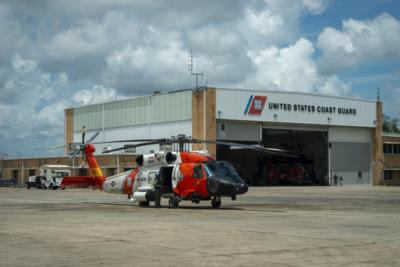Heroic Efforts Save One of Two Victims
The United States Coast Guard rescued one person found stranded on a channel marker and recovered a second, unresponsive individual from icy waters after a vessel capsized on the Columbia River near Astoria, Oregon.

At 14:25 PDT on Sunday, 11 June 2023, a shore-bound witness notified Coast Guard Sector Columbia River watchstanders of a boat having capsized and two people entering the water east of Tongue Point—a peninsula on the Columbia River’s south bank, some 11-nautical-miles east of the waterway’s confluence with the North Pacific Ocean.
A Coast Guard Air Station Astoria MH-60 Jayhawk helicopter crew and a Coast Guard Station Cape Disappointment 29-foot Response Boat-Small II crew were dispatched to the scene.
At 15:00 PDT, the air-crew arrived in the vicinity of Tongue Point and located one person stranded atop a dayboard channel marker. In maritime parlance, the term dayboard describes a conical form affixed to the top of a sea mark or other navigational aid for purpose of indicating its status by day.
A rescue swimmer deployed from the helicopter to retrieve the stranded individual and, in short order, both rescue swimmer and victim were hoisted aboard the hovering MH-60.
Remaining on scene and continuing its search of the area, the air-crew, at 15:22 PDT, located a second person floating face-up but motionless in the river.
The responding USCG boat-crew, owing to the shallowness of the water surrounding Tongue Point, was unable to reach the second victim. Ergo, the rescue swimmer was again lowered from the helicopter. Upon reaching the second victim, the rescue swimmer observed the individual to be unresponsive and not breathing.
Notwithstanding the second victim’s precipitous transport to the nearby USCG vessel and the rescue swimmer’s protracted administration of cardiopulmonary resuscitation, the individual remained unresponsive when transferred from Coast Guard care to emergency medical personnel waiting at the East Mooring Basin.
Though reportedly in stable condition, the victim rescued from the channel marker was transported by the helicopter crew to Air Station Astoria and consigned to the care of medical personnel.
Created by Congress as the Revenue-Marine on 04 August 1790, the U.S. Coast Guard (USCG) is the oldest continuously operating naval service of the United States. The Semper Paratus (Always Ready) motto to which the Coast Guard aspires speaks to the outfit’s ethos and the nature of its humanitarian and security missions.
Stated simply, the Coast Guard protects the United States' borders and defends her sovereignty by safeguarding sea lines of communication and commerce across 95,000-miles of U.S. coastline and the entirety of the U.S. Exclusive Economic Zone. This critical work is carried out by 44,500 active-duty personnel, 7,000 reservists, and 8,577 full-time civilian employees.

The USCG’s fleet of roughly 250 coastal and ocean-going cutters, patrol ships, buoy tenders, tugs, and icebreakers; as well as nearly two-thousand small boats and specialized craft constitutes the world’s 12th largest naval force. The service’s aviation division comprises north of two-hundred helicopters and fixed-wing aircraft the likes of the AC-37A (Gulfstream V), HC-144A (Airbus CN-235), and Lockheed’s mighty HC-130 Hercules utility turboprop transport. To supplement the aforementioned and better support its homeland security and search & rescue operations, the Coast Guard is building an unmanned aerial vehicle (UAV) program around General Atomics’ MQ-9 Reaper platform.
In its humanitarian capacity, the U.S. Coast Guard saves tens-of-thousands of lives every year and provides emergency response and disaster management for all manner of man-made emergencies, meteorological exigencies, and outright natural disasters.
 ANN's Daily Aero-Term (04.26.24): DETRESFA (Distress Phrase)
ANN's Daily Aero-Term (04.26.24): DETRESFA (Distress Phrase) ANN's Daily Aero-Linx (04.26.24)
ANN's Daily Aero-Linx (04.26.24) Airborne 04.22.24: Rotor X Worsens, Airport Fees 4 FNB?, USMC Drone Pilot
Airborne 04.22.24: Rotor X Worsens, Airport Fees 4 FNB?, USMC Drone Pilot Airborne 04.24.24: INTEGRAL E, Elixir USA, M700 RVSM
Airborne 04.24.24: INTEGRAL E, Elixir USA, M700 RVSM Airborne-NextGen 04.23.24: UAVOS UVH 170, magni650 Engine, World eVTOL Directory
Airborne-NextGen 04.23.24: UAVOS UVH 170, magni650 Engine, World eVTOL Directory




